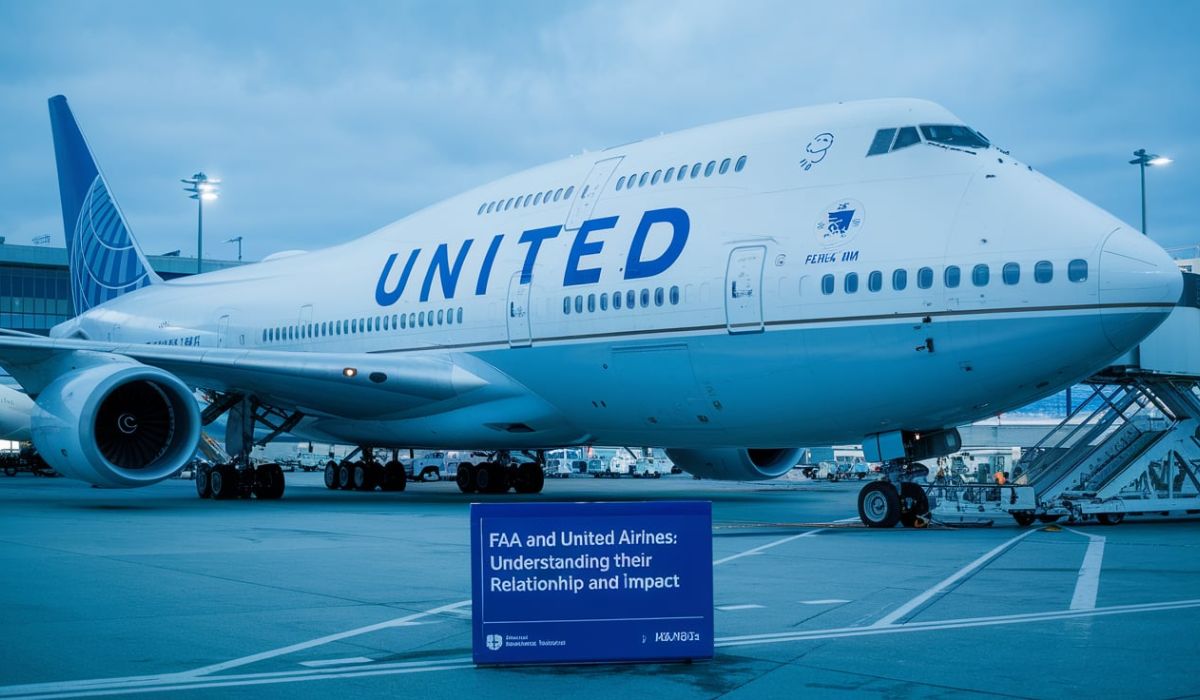The relationship between the FAA (Federal Aviation Administration) and United Airlines is one that plays a crucial role in ensuring safe, efficient, and reliable air travel. But what exactly does this connection entail? How does the FAA regulate United Airlines, and what responsibilities do they share in maintaining the integrity of air travel in the United States? In this article, we’ll explore the dynamic between the FAA and United Airlines, offering insights into their collaboration, challenges, and the impact on passengers.
Introduction to FAA and United Airlines

In the world of air travel, safety and regulations are non-negotiable. The FAA (Federal Aviation Administration) is the primary body responsible for regulating all aspects of civil aviation in the U.S., while United Airlines is one of the largest and most prominent airlines in the world. The relationship between the two is integral to maintaining smooth operations in the air travel industry. But what exactly is the role of each party, and how do they work together? This article will break it down in an easy-to-understand manner.
What is the FAA and What Role Does it Play in Aviation?
The FAA is a U.S. government agency responsible for overseeing civil aviation safety, air traffic management, and regulating the behavior of airlines. Essentially, the FAA ensures that air travel is safe, secure, and meets established standards. It establishes rules, conducts inspections, certifies aircraft and pilots, and manages air traffic control systems. Without the FAA, the aviation industry would not be as safe or organized as it is today.
For United Airlines, the FAA plays a vital role in ensuring that the airline adheres to safety standards, follows operational protocols, and remains compliant with federal laws.
United Airlines: A Snapshot of its History and Operations
United Airlines, founded in 1926, has grown to become one of the biggest airlines in the world. With a fleet of hundreds of aircraft and routes that span across the globe, United plays a significant role in both domestic and international air travel. Its operational success is, in part, thanks to its adherence to FAA regulations, which ensures the airline maintains the highest levels of safety, customer service, and efficiency.
FAA Regulations: How They Impact United Airlines

The FAA sets numerous regulations that directly impact how United Airlines operates on a day-to-day basis. These regulations cover areas such as:
- Flight Operations: How flights are scheduled and operated.
- Aircraft Maintenance: Standards for keeping planes in top shape.
- Crew Training: Requirements for pilots and flight attendants.
- Safety Procedures: Rules about emergency protocols and passenger safety.
Each of these regulations helps to ensure that United Airlines’ operations meet federal standards, protecting both passengers and employees.
Safety Standards and Inspections: A Joint Effort
The FAA is in charge of establishing safety standards, but it is up to airlines like United Airlines to ensure they are implemented. This means that United Airlines regularly undergoes inspections by FAA representatives, who check everything from the structural integrity of aircraft to crew competency. These inspections are thorough and ensure that any potential safety hazards are addressed promptly.
Additionally, United Airlines is responsible for submitting regular reports to the FAA, which helps the agency monitor the airline’s compliance with regulations.
United Airlines’ Commitment to FAA Regulations
United Airlines is dedicated to ensuring that its fleet, crew, and operations are fully compliant with FAA regulations. The airline’s commitment goes beyond just meeting the minimum requirements. United has invested heavily in safety technologies, pilot training programs, and aircraft maintenance systems to exceed industry standards.
In addition, United Airlines is proactive in collaborating with the FAA on new safety protocols and industry initiatives. This helps the airline remain at the forefront of aviation safety and innovation.
The FAA’s Role in United Airlines’ Fleet Maintenance

Maintaining a fleet of hundreds of aircraft is no small feat, and the FAA plays an essential role in ensuring that United Airlines’ planes are in optimal condition. The FAA establishes the standards for aircraft maintenance, and airlines are required to adhere to these guidelines.
From routine checks to more intensive repairs, the FAA ensures that every plane in United Airlines’ fleet meets or exceeds the safety and mechanical standards set forth. These checks are not only critical for safety but also for ensuring the airline operates efficiently.
Passenger Experience: How FAA Regulations Shape Your Flight
Have you ever wondered why your flight has certain rules or why the crew conducts specific safety procedures before takeoff? It all boils down to FAA regulations. These rules are designed to keep you safe, whether it’s in how the crew responds to emergencies or how the aircraft is equipped for passenger comfort.
For example, FAA guidelines regulate seatbelt use during takeoff and landing, ensuring you remain safe. These protocols, while sometimes inconvenient, are there for your protection.
The Impact of FAA-United Airlines Collaboration on Delays
Air travel is sometimes unpredictable, and delays are inevitable. However, the collaboration between the FAA and United Airlines helps mitigate and manage delays. The FAA oversees air traffic control, which can sometimes cause delays due to high traffic in the skies. Meanwhile, United Airlines ensures that its flights are prepared to leave on time, addressing any operational issues that might delay a departure.
Together, both entities work to reduce delays and maintain the best possible experience for passengers, even when things go awry.
United Airlines and FAA: A Partnership for Sustainable Aviation
In recent years, sustainability has become a major priority for the aviation industry. Both the FAA and United Airlines are committed to reducing the environmental impact of air travel. United Airlines has implemented various measures to reduce its carbon footprint, such as investing in more fuel-efficient aircraft and exploring alternative fuels.
On the other hand, the FAA plays a role by regulating emissions standards and providing incentives for airlines that adopt more eco-friendly practices. Together, they are working toward a future where air travel is both safe and environmentally sustainable.
FAA’s Role in Addressing United Airlines’ Safety Incidents
When a safety incident occurs on a United Airlines flight, the FAA steps in to investigate the cause. The FAA has a strict protocol for reviewing safety events, from minor incidents to more severe accidents. This thorough investigation helps identify the root causes and allows both the FAA and United Airlines to implement corrective actions.
These investigations not only improve safety at United Airlines but also enhance safety measures across the airline industry as a whole.
United Airlines’ Efforts to Meet FAA Compliance Standards
Meeting FAA standards is an ongoing process. United Airlines goes above and beyond to ensure that all aspects of its operation comply with federal regulations. From ensuring that its aircraft are properly maintained to providing top-notch training for its pilots, United Airlines strives to exceed the minimum FAA standards, creating a safer and more reliable service for its passengers.
How Does FAA’s Oversight Affect United Airlines’ Employees?
The FAA’s regulations also affect the employees of United Airlines. For example, pilots must meet strict FAA training and certification standards before they are allowed to operate commercial flights. Similarly, flight attendants, maintenance staff, and ground crew must follow FAA guidelines to ensure a smooth and safe flight experience.
Future Prospects for FAA-United Airlines Relations
As air travel continues to evolve, so too will the relationship between the FAA and United Airlines. With new technologies, environmental goals, and growing concerns about passenger safety, both entities will need to work even more closely together to meet future challenges.
Conclusion
The collaboration between the FAA and United Airlines is critical to the safety, efficiency, and overall experience of air travel in the U.S. By adhering to FAA regulations, United Airlines not only ensures the safety of its passengers and crew but also helps advance the future of aviation. This partnership between the two entities continues to shape the future of air travel, benefiting everyone who takes to the skies.
FAQs about FAA and United Airlines
1. What role does the FAA play in United Airlines’ operations?
The FAA regulates United Airlines’ safety standards, flight operations, aircraft maintenance, and crew training to ensure safe air travel.
2. How often does United Airlines undergo FAA inspections?
United Airlines is subject to regular FAA inspections, which ensure that its planes and operations comply with safety regulations.
3. What happens if United Airlines violates FAA regulations?
If United Airlines violates FAA regulations, the airline may face penalties, fines, or other corrective actions to ensure compliance.
4. How do FAA regulations affect my flight experience?
FAA regulations govern safety procedures, aircraft maintenance, and flight operations, ensuring a safer and more comfortable flight experience for passengers.
5. Is United Airlines involved in environmental efforts with the FAA?
Yes, both United Airlines and the FAA are working toward sustainable aviation, with United investing in fuel-efficient aircraft and alternative fuels while the FAA sets emission standards.
